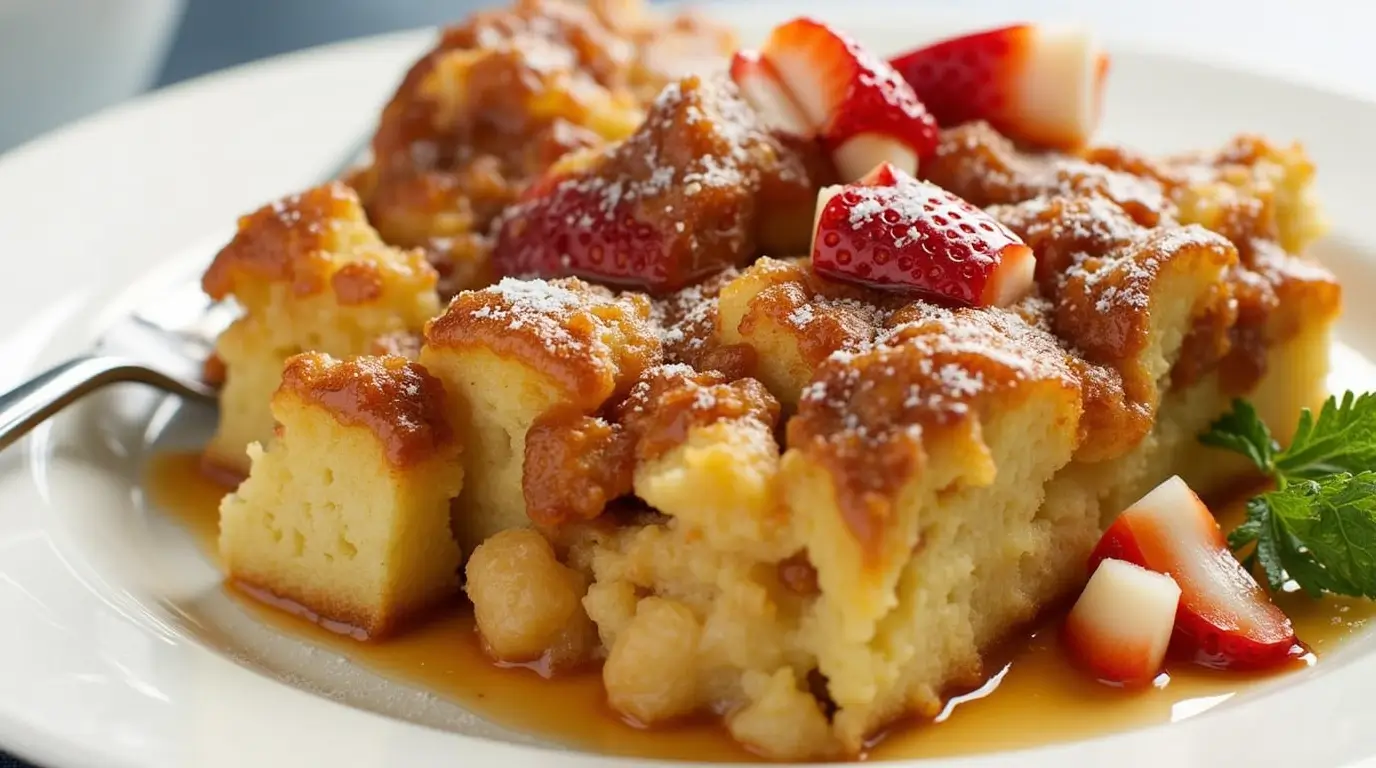There’s nothing quite like waking up to the warm, inviting smell of a French toast casserole baking in the oven. But when your dish turns out soggy instead of golden and crisp, it can feel like a real breakfast bummer. So, why is my French toast casserole soggy? That’s the question we’re diving into today. In this guide, we’ll uncover the most common reasons for this culinary misstep and provide actionable tips to help you create a perfectly baked dish every time. Whether it’s too much liquid, the wrong bread, or a baking error, you’ll learn how to troubleshoot and prevent soggy casseroles like a pro.
Why Is My French Toast Casserole Soggy? Common Causes
Too Much Liquid in the Custard
One of the leading culprits behind a soggy French toast casserole is excess liquid. While the custard mixture—usually made with eggs and milk—is the heart of the dish, using too much can overwhelm the bread. Bread is like a sponge, but even sponges have limits. If the custard isn’t absorbed properly, the casserole can end up mushy and wet rather than creamy and tender. To avoid this, stick to a balanced ratio, such as 1 cup of milk to 2 eggs, and ensure you’re not oversaturating the bread.
Incorrect Bread Selection
Not all bread is created equal when it comes to French toast casseroles. Using bread that’s too soft, like sandwich bread, or bread that’s too fresh can lead to disaster. Stale or slightly dried-out bread works best because it absorbs the custard evenly without becoming overly saturated. Brioche, challah, or even sourdough are excellent choices, as they offer a sturdy texture and a hint of sweetness.
Insufficient Baking Time
Underbaking is another sneaky reason your casserole might come out soggy. The custard needs enough time to set fully, and the bread needs to crisp up. If you pull the dish out too early, you’ll end up with an undercooked center. To ensure success, bake the casserole at 350°F (175°C) for 40–50 minutes, or until the top is golden and a knife inserted into the middle comes out mostly clean.
Overcrowding in the Casserole Dish
Cramming too much bread into a small dish can prevent proper baking. When the bread pieces are packed too tightly, the custard doesn’t distribute evenly, leaving some parts undercooked and soggy. To fix this, use a dish that’s large enough for the bread to spread out in a single, even layer. This allows for better airflow and ensures every bite is baked to perfection.
Low or Improper Oven Temperature
The temperature of your oven can make or break your casserole. If the oven is too low, the custard won’t set, and the bread won’t crisp. Always preheat your oven and use a thermometer to confirm the temperature. Baking at 350°F is the sweet spot for most French toast casseroles. Avoid the temptation to rush the process with a higher temperature—it could burn the top before the inside cooks through.

How to Prevent a Soggy French Toast Casserole
Using Stale Bread for Better Absorption
To prevent sogginess, choosing the right bread is essential. Stale bread is your best friend when making French toast casserole. It absorbs the custard without breaking down, ensuring the final dish is moist but not overly wet. If you don’t have stale bread on hand, you can dry fresh bread by placing slices on a baking sheet and warming them in a low oven (around 200°F) for 10–15 minutes. This trick creates the perfect base for soaking up the custard evenly.
Balancing the Milk-to-Egg Ratio in Custard
The balance of milk and eggs in your custard is crucial. Too much milk can overwhelm the bread, while too few eggs won’t provide enough structure to hold the dish together. A good rule of thumb is to use 1 cup of milk for every 2 large eggs. Add spices like cinnamon and nutmeg sparingly—they bring warmth and depth but should never overpower the custard. Measuring carefully and mixing thoroughly will help you avoid the classic problem of “Why is my French toast casserole soggy?”
Choosing the Right Baking Dish
Your choice of dish can significantly impact the texture of your casserole. A shallow, wide baking dish works better than a deep one because it allows the bread and custard to cook evenly. Overcrowding the bread in a small dish leads to uneven baking, with some parts overcooked while others remain soggy. Ensure the bread is spread out in an even layer for consistent results.
Optimal Oven Temperature and Timing
Baking your casserole at the right temperature for the proper amount of time is key to success. Preheat your oven to 350°F, and bake for 40–50 minutes, checking for doneness around the 40-minute mark. The casserole should be golden-brown on top and set in the middle. If you’re unsure, insert a knife into the center—it should come out mostly clean, with just a few moist crumbs.
Adding Toppings to Manage Excess Moisture
Toppings like cinnamon sugar or a layer of sliced fruit not only enhance the flavor but also help absorb excess moisture. For example, fresh berries or apple slices can add a burst of sweetness while preventing the custard from pooling at the bottom. Additionally, a sprinkling of granulated or brown sugar creates a caramelized crust, offering both texture and flavor.
Troubleshooting Soggy French Toast Casserole
Extending Baking Time for Proper Texture
If your French toast casserole is still soggy after the recommended baking time, don’t panic! Sometimes, the custard just needs a little extra time to set. Cover the dish loosely with foil to prevent over-browning, then return it to the oven for another 10–15 minutes. This additional time allows the custard to firm up without drying out the bread.
Using the Broiler to Add Crispness
For a quick fix, try using your oven’s broiler. Set the broiler on high and place the casserole on the middle rack. Watch it closely—just 2–3 minutes under the broiler can create a beautifully crisp, golden top layer while drying out any remaining moisture. Be careful not to leave it too long, as the top can burn quickly.
Repurposing the Dish as a Breakfast Strata
If all else fails and your casserole remains soggy, consider turning it into a savory breakfast strata. Add shredded cheese, cooked vegetables, or crumbled bacon, then bake until heated through. This transformation not only salvages the dish but also turns it into something entirely new and delicious.

Creative Twists on French Toast Casserole
Exploring Savory Variations
If you’re ready to step beyond the traditional sweet flavors, savory French toast casseroles offer an exciting twist. Replace the classic custard with a mix of eggs, milk, and savory seasonings like herbs and garlic. Adding ingredients like sautéed spinach, shredded cheese, or cooked sausage transforms the dish into a hearty breakfast or brunch option. These savory alternatives not only answer the question “Why is my French toast casserole soggy?” but also add variety to your recipe collection.
Experimenting with Sweet Toppings
For those who love a touch of indulgence, experimenting with sweet toppings can elevate your French toast casserole. Try caramelized bananas, a drizzle of honey, or a dusting of powdered sugar. Topping the dish with fruit compote or fresh berries adds both color and flavor, while crushed nuts or granola provide a satisfying crunch. These enhancements create balance and prevent the custard from pooling at the bottom of the dish.
Customizing with Seasonal Ingredients
Incorporating seasonal ingredients is a fun way to adapt your casserole throughout the year. During the fall, consider adding pumpkin puree and spices like nutmeg and cloves. For summer, fresh peaches or a citrus glaze make delightful additions. Not only do these seasonal touches enhance flavor, but they also help you avoid the sogginess often associated with overloading the custard.
For more recipe inspiration, check out Kamala Recipes’ brioche French toast casserole guide.
Nutritional Considerations for French Toast Casserole
Caloric Breakdown of the Dish
The calories in a French toast casserole depend on the ingredients you use. A typical serving with brioche, eggs, milk, and sugar averages around 350–400 calories. Additional toppings like syrup or whipped cream can increase this count. For those wondering, “Why is my French toast casserole soggy?” it could be due to calorie-heavy additions that add unnecessary moisture, like excess cream or syrup.
Making Healthier Adjustments
To lighten the dish, you can substitute whole milk with almond or oat milk. Reducing sugar or using natural sweeteners like honey keeps it flavorful without adding empty calories. Adding fresh fruit also boosts its nutritional value.
Serving Suggestions and Pairings
Drinks to Complement the Casserole
A warm, satisfying dish like French toast casserole pairs beautifully with a variety of drinks. For breakfast, coffee or a latte enhances the sweet, spiced flavors of the casserole. If you’re serving it for brunch, a mimosa or a glass of sparkling water with citrus adds a refreshing touch. For a non-caffeinated option, herbal teas like chamomile or peppermint work wonderfully.
Sides for a Balanced Meal
Pairing your casserole with thoughtful sides transforms it into a complete meal. Fresh fruit, like a bowl of berries or sliced oranges, balances the richness of the dish. For a savory twist, serve it with crispy bacon or scrambled eggs. Additionally, a dollop of Greek yogurt with granola provides texture and a boost of protein. These combinations not only enhance the dish but also keep the question, “Why is my French toast casserole soggy?” at bay, as they prevent you from overloading it with excess toppings or sides.
By choosing the right drinks and sides, you’ll elevate your casserole into a meal that’s both satisfying and memorable!

FAQs About Why Is My French Toast Casserole Soggy?
Can I Make French Toast Casserole Ahead of Time?
Yes! Preparing your casserole the night before is a great way to save time. Assemble the dish, cover it with plastic wrap, and store it in the refrigerator. This allows the bread to soak up the custard evenly. However, be careful not to over-soak, as this can lead to the common problem of “Why is my French toast casserole soggy?”.
What Type of Bread Works Best?
Stale or slightly dried-out bread, such as brioche or challah, is ideal for French toast casseroles. These types of bread have a dense texture and absorb the custard without falling apart. Avoid using soft sandwich bread, which tends to become overly mushy.
How Do I Fix a Soggy Casserole After Baking?
If your casserole turns out soggy, you can try baking it for an additional 10–15 minutes to help the custard set. Alternatively, placing it under the broiler for a few minutes can create a crisp top layer while reducing excess moisture.
What Are the Best Toppings for French Toast Casserole?
Toppings like fresh fruit, cinnamon sugar, or whipped cream add flavor and texture to your dish. You can also try syrups, nuts, or even a dollop of yogurt for a healthier option.
These FAQs address the most common concerns, ensuring your casserole turns out perfectly every time!
Mastering the Perfect French Toast Casserole
A French toast casserole is a delightful dish that can transform any breakfast or brunch into something special. However, a soggy casserole can quickly dampen your excitement. By understanding the common pitfalls, like too much liquid, improper bread choice, or insufficient baking time, you can easily answer the question, “Why is my French toast casserole soggy?” With the right tips and techniques—using stale bread, balancing the custard, and baking at the correct temperature—you’ll achieve a golden, crispy, and perfectly set casserole every time.
Moreover, experimenting with creative variations and thoughtful pairings ensures your dish is always fresh and exciting. Whether you opt for sweet toppings, savory twists, or seasonal ingredients, the possibilities are endless. With these insights, you can confidently master this classic recipe and enjoy a flawless French toast casserole for any occasion. So, grab your favorite ingredients, preheat your oven, and start baking your way to breakfast perfection!


